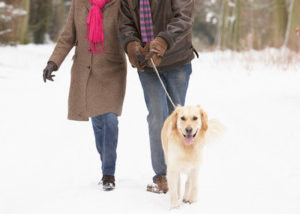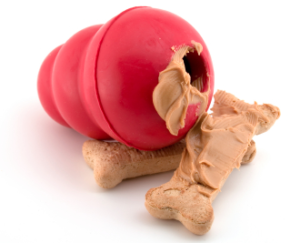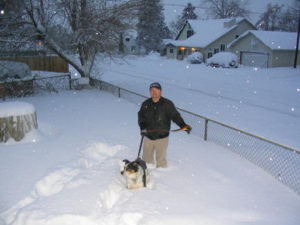Photo Credit: Frank Grace
BEFORE THE STORM:
ID Tag/Microchip:
Have your dog’s updated ID tags on their collar and the collar on them at all times during a storm. We recommend having your cell phone on your dog’s tag and that you have a dog licence from your municipality. Also, have your dog microchipped and the information kept up-to-date with the chip company/vets. If you don’t have a tag available, as a temporary ID use a black marker to write your cell number either on tape around or the webbing of their collar.
Long Walk:
Take your dog for a long walk as you both may be housebound for a few days.
Food and Meds:
Make sure you have enough dog food and medications in stock for both you and your dog. They recommend at least 72 hours worth.
Winter Dog Gear:
Get out your dog coats/sweaters and boots because when your dog has to go, they have to go. People will be using a lot of salt with this ice build up, so be prepared with dog boots or ointments to reduce the risk to your dogs pads. Have towels ready to dry off your dog after being out in the storm.
Evacuation:
Prepare ahead of time and have a plan for your family and your pets incase you had to evacuate your home. You can find a great article on planning ahead for your pets safety during an evacuation here. And disaster preparedness for pets here.
Have toys ready for indoor play:
Stuff kong’s with your dogs food or special treats, use interactive toys where both you and your dog work together, have chew toys ready: Your dog will be anxious and active and you will need to burn some of that energy off while indoors.
Print a copy of this list:
You can find a copy of this list for printing here.
Thunder and Lightning Safety:
Please read the info provided at this link for information on keeping your dog calm during a Thunderstorm:
DURING THE STORM:
Outside for bathroom breaks only:
Limit the time you and your dog spend outside during the storm. Ice makes the streets and sidewalks dangerous and the storm itself may cause havoc. Don’t forget your own cleats for your boots as everywhere you step will be icy. (Information on hypothermia in dogs can be found here.)
Leashed when outside:
Please keep them on leash, even within a fenced yard during the storm. Winds, heavy ice build up, noise of salt trucks, falling branches, etc. All these things can cause your dog to bolt. A dog bolting from fear can leap high fences and/or run for long distances.
Stay Inside During Worst Part of Storm:
The risks are too high during the worst part of a storm, so be prepared to keep your dog inside and safe. Take your dog out before the worst hits, create a potty area/pee pad inside your home so your dog is comfortable. Don’t feed your dog during the worst part of the storm.
Power Outage:
Stay calm so your dog stays calm as well.
Don’t forget to keep your dog warm by providing them with blankets or sweaters.
While shovelling/salting/cleaning up:
Please keep your dog leashed or tethered when they are out with you shovelling/salting/cleaning up. Often people let their dogs play in the snow while they shovel out the cars and driveway. With snowplows, high winds, and all the other dangers out there, we advise that your dog be on a long line, on a leash, tethered safely or simply kept indoors.
Speak out if you see a pet left in the cold:
Call your local Animal Control or the Provincial SPCA Cruelty Investigations to report a dog left out in the cold. You could also try your local Police or RCMP. Contact Information listed by County for Nova Scotia can be found here: www.ns.lostdognetwork.com/contact-list/ If you feel comfortable, doing so at your own risk, please consider offering this pet shelter, in your home, basement, garage, or even a shed. You should also report finding this pet to local online community pages (lost pets, community centres, yard sales, etc.) and place a free ad on Kijiji.ca under Pets: Lost and Found. Thank you.
AFTER THE STORM:
Before you let your dog out, check your yard:
Thoroughly check the yard after the storm for any gates blown open by high winds, broken fence sections, hanging or downed branches/trees, power lines down, live wires, etc.
Road Salts:
After a snow storm the sidewalks may be very icy and/or covered in road salt. “When you get back inside, wipe down (or wash) your pet’s feet, legs and belly to remove these chemicals (road salt) and reduce the risk that your dog will be poisoned after (s)he licks them off of his/her feet or fur.”* Or consider getting winter boots for your dog:

















I got accused of letting my dog run at large but they have the wrong dog. After the first call we got from Animal Control we do not let our dog out of our sight there is a invisible fence going up just as soon as it gets delivered to us . Not very happy that my dog gets accused when there is 2 other brown and black shepherds running lose here and my dog is beige not black and brown and my dog isn’t a shepherd she is a nova scotia duck trollor.